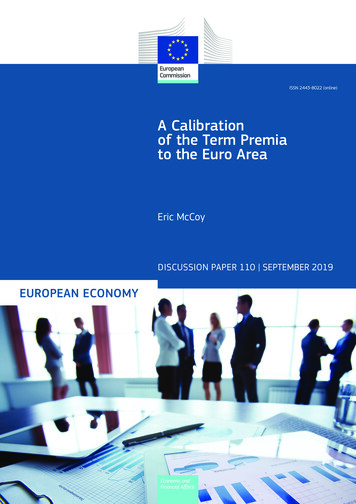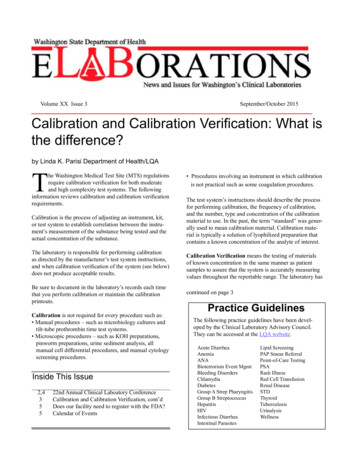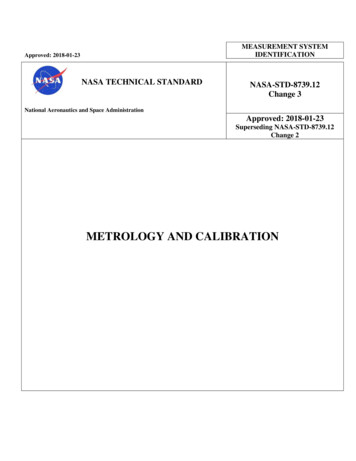
Transcription
ISSN 2443-8022 (online)A Calibrationof the Term Premiato the Euro AreaEric McCoyDISCUSSION PAPER 110 SEPTEMBER 2019EUROPEAN ECONOMYEUROPEANEconomic andFinancial Affairs
European Economy Discussion Papers are written by the staff of the European Commission’sDirectorate-General for Economic and Financial Affairs, or by experts working in association with them, toinform discussion on economic policy and to stimulate debate.The views expressed in this document are solely those of the author(s) and do not necessarily represent theofficial views of the European Commission.Authorised for publication by Lucio Pench, Director for Fiscal Policy and Policy Mix.LEGAL NOTICENeither the European Commission nor any person acting on behalf of the European Commission is responsiblefor the use that might be made of the information contained in this publication.This paper exists in English only and can be downloaded c-and-financial-affairs-publications en.Luxembourg: Publications Office of the European Union, 2019PDFISBN 978-92-79-77447-8ISSN 2443-8022doi:10.2765/33831KC-BD-18-037-EN-N European Union, 2019Non-commercial reproduction is authorised provided the source is acknowledged. For any use or reproductionof material that is not under the EU copyright, permission must be sought directly from the copyright holders.
European CommissionDirectorate-General for Economic and Financial AffairsA Calibration of the Term Premia to the Euro AreaEric McCoyAbstractCredit risk-free long-term interest rates can typically be decomposed into two components: expectations ofthe future path of the short-term policy rate and the term premium. Changes in term premium areconsidered to have been an important driver behind developments in long-term bond yields in recent years.As policy rates of major central banks approached their effective lower bound in the aftermath of the globalfinancial crisis, their ability to provide the necessary degree of monetary stimulus using conventional policymeasures became very limited. In this particular context, central banks had to move beyond conventionalpolicy instruments and instead deploy a set of unconventional tools (such as large-scale asset purchaseprograms and forward guidance) that were tailored to target the longer-end of the yield curve. There is agrowing body of empirical evidence suggesting that these unconventional measures turned out to beeffective in compressing the term premium component of interest rates. This paper, after providing adefinition of the term premium and a succinct overview of different ways to measure it, presents theempirical results obtained from calibrating a Gaussian affine term structure (GATSM) based term premiamodel to the euro area. In addition to discussing the GATSM model’s assumptions and specifications, italso describes the calibration algorithm employed, which is based on genetic algorithms. Thereafter, itprovides some insight into the time profile of the euro area term premium in the post global financial crisis(GFC) era and in particular how it has evolved after key ECB policy decisions since 2008.JEL Classification: E43, E44, E52, E58.Keywords: monetary policy, term premia, term structure models, genetic algorithms.Acknowledgements: I would like to thank Anton Jevčák, Eric Ruscher, Matteo Salto and PhilippPfeiffer for their helpful comments and feedback on the paper. In addition, I am very grateful to LeoKrippner for the help he provided in answering various technical questions.Contact: Eric McCoy, European Commission, Directorate-General for Economic and Financial Affairs,eric.mccoy@ec.europa.eu.EUROPEAN ECONOMYDiscussion Paper 110
CONTENTS1.INTRODUCTION . 52.A NON-TECHNICAL OVERVIEW OF THE TERM PREMIA . 62.1. What is the term premium?62.2. What are the different ways to extract the term premium?92.3. A gatsm-based term premia model3.11CALIBRATING THE TERM PREMIUM MODEL. 143.1. The calibration dataset143.2. The calibration algorithm144.EMPIRICAL RESULTS FOR THE TERM PREMIA. 165.THE TERM PREMIA AND UNCONVENTIONAL MONETARY POLICY . 206.CONCLUSION . 237.TECHNICAL ANNEX. 248.7.1. A term structure-based term premia247.2. Calibrating the term-premia model28REFERENCES . 303
1.INTRODUCTIONThe term structure of interest rates can be a valuable source of information for central bankers as itprovides insights into market expectations about the economy and their evolution in response tochanges in economic conditions. The yield curve can also serve as a tool to assess the impacts ofcentral bank policy decisions and communications. However, a proper interpretation of yield curveinformation by central banks requires separating expectations of future short-term policy rates fromthe so-called “term premium” component embedded in interest rates. The term premium reflects theexcess return that an investor demands as compensation for holding a bond with a long maturity (forexample a bond maturing in 10 years) relative to rolling over a short-term bond until this long-datedmaturity1. Locking into a long-dated fixed income investment for a period of time is not equivalent torolling over a short-term investment for the same period, because holding the long-dated bond exposesthe investor to the risk that interest rates may increase unexpectedly during the holding period. Anunexpected increase in interest rates causes a market loss on the investment position in fixed-ratesecurities. As will be explained in further details later on, the term premium compensates investors fortaking on such interest rate or duration risk2.In recent years, understanding the term premium has attracted considerable attention. Indeed, explicitreference to the term premium – which was previously considered a rather obscure part of academicjargon – has become commonplace in policy discussions and central bank communications. This maybe linked to the fact that the decade following the Global Financial Crisis (GFC) of 2008 has beenmarked by historically low interest rates, even at the long end of the yield curve. The observed gradualdecline in benchmark 10-year government bond yields across major economies has generated muchinterest in trying to understand both the source of this decline as well as its economic implications. Toshed more light on the observed decline in long-term yields, a growing number of academics haveresorted to use dynamic term structure models which divide yields into these two components – apolicy rate expectations component and a term premium component. The expectations componentreflects the average of current and future expected short-term policy rates over the maturity of thebond. If the pure expectations hypothesis of the term structure were to hold, this would be all thatmattered in terms of explaining movements in long-term rates. But broad empirical3 evidence suggeststhat the pure expectations hypothesis fails to hold true in practice and that, in addition, there exists atime-varying premium that investors require in order to hold a long-term bond instead of simplyrolling over a series of short-term bonds. This has implication for the conduct of monetary policy as itstransmission (in particular of unconventional policy measures) depends not only on the expectationscomponent, but also the term premium component.Accordingly, a central bank can seek to influence the level and shape of the yield curve by acting ontwo components of the long-term interest rates: the expectations component and the term premium.The expectations component reflects market expectations of the future path of the short-term policyrate. All else equal, a path that is lower and shallower tends to produce a lower level of long-termyields and a flatter yield curve. Since the onset of the GFC, the ECB has adopted a series ofunconventional monetary policy measures to bring inflation rates back to levels below, but close to,2% over the medium term. These measures have included targeted longer-term refinancing operations(TLTROs), lowering the deposit facility rate into negative territory, and an expanded asset purchaseprogram (APP) targeting a variety of investment-grade private and public sector securities. This set ofmeasures has been underpinned by forward guidance on the key ECB interest rates which was first1This definition of the term premium is commonly employed in the literature as well as in central bank speeches (see forexample the ECB speech of Peter Praet “Maintaining price stability with unconventional monetary policy measures”, MMFMonetary and Financial Policy Conference, London, October 2017).2 Duration risk refers to the risk associated with the sensitivity of a bond's price to a one percent change in interest rates. Thehigher a bond's duration, the greater its sensitivity to interest rates changes.3 See for example Sarno, Thornton and Valente (2003) who provide empirical evidence that the expectations hypothesis failsto hold in practice.5
introduced in July 2013 when the ECB’s Governing Council stated that it expected interest rates toremain low for an extended period of time. Since then the ECB’s forward guidance has been adaptedon a number of occasions such that nowadays it clarifies the Governing Council’s intentions not onlywith respect to the expected future path of short term policy rates, but also with regard to the horizonof its asset purchase program.This paper presents the empirical results obtained from calibrating a Gaussian affine term structure(GATSM) based term premia model to the euro area and it is organised as follows: Section 2 providesa non-technical overview of what the term premium is, what the different ways to measure it, and whatare the broad classes of models to extract term premia. A particular focus is given to the class ofGaussian affine term structure models (GATSM) and how these can be used to extract the termpremium component. Section 3 discusses how to calibrate the GATSM-based term premia model toyield curve data as well as the technical challenges and hurdles which need to be considered. Section 4then goes on to present the results obtained from calibrating the term structure based term premiamodel to the euro area (EA) as well as to the US. In Section 5 we discuss the time profile of the EA10-year term premium in the post GFC era and in particular how it evolved after key ECBunconventional monetary policy decisions were being implemented. Finally, Section 6 concludes thepaper and Section 7 (technical appendix) provides a succinct technical overview of the GATSM-basedterm premia model presented in this paper.The paper is designed in such a way as to appeal to two groups of readers: (1) those with priorknowledge of term-structure modelling and term premia models and (2) readers without such technicalbackground knowledge. The latter group might primarily be interested in the practical application ofthe term premia model to the fields of macroeconomics, monetary policy and financial markets (bondpricing, interest rate risk management ). This group of readers is invited to start by reading Section2 which provides a non-technical overview of the term premia model presented in this paper, and thensubsequently jump to Sections 4 and 5 which in turn discuss the empirical results obtained from theterm premia model (both for EA and the US) as well as how well the 10-year term premium in the EAresponded to key monetary policy events. The first group of readers, with a background in termstructure modelling and knowledge of the term premia literature, will be essentially interested in themathematical underpinnings of the term premia model presented in this paper as well as the calibrationmethod proposed (based on genetic algorithms). This group of readers is thus invited to skip the nontechnical review and directly start with Section 3, which discusses the calibration algorithm in moredetail in addition to the yield curve dataset used for the calibration, followed by Section 4, whichdiscusses the calibration results obtained. Section 7 in addition offers a succinct technical overview ofthe GATSM-based term premia model presented in this paper. As the paper is designed to addressboth readers with and without knowledge of term-structure modelling, reiterations of certain keyaspects throughout the paper are inevitable.2.A NON-TECHNICAL OVERVIEW OF THE TERM PREMIA2.1WHAT IS THE TERM PREMIUM?The oldest and most debated theory underlying the term structure of interest rates is the expectationshypothesis. According to this theory, the expected return from holding a long-term bond until maturity(for example expiring in 10 years) should be the same as the expected return from rolling over a seriesof short-term bonds (for example each having a one year maturity) such that the total rollover maturityis equal to that of the long-term bond. Another equivalent way to re-express this hypothesis is to saythat the long bond yield is equal to the average of the expected short-term rates, or also that theforward rate (the interest rate which investors fix now to borrow or lend in the future) should be equalto the interest rate expected to prevail in the future. Empirically, the expectations hypothesis haslargely failed to fully explain the behavior of interest rates. Several academic papers including Fama(1984), Fama and Bliss (1987), Campbell and Shiller (1991), Stambaugh (1988), Cochrane and6
Piazzesi (2005), Sarno Thornton and Valente (2003), amongst others, have pointed out evidence insupport of non-zero and time-varying risk premia in bond markets, thus violating the expectationshypothesis.Although the expectations hypothesis provides a simple and intuitively appealing interpretation of theyield curve, it ignores one very fundamental reality which investors must face in financial markets:interest rate risk. Except if held until maturity, the nominal return on a long maturity bond is uncertain(i.e. the market price of a long-term bond can vary a lot even from one day to the next), and investorsrequire compensation for bearing this risk. The “term premium” refers to such compensation and anyother sources of deviation from the expectations hypothesis. In addition to pure market interest raterisk, there could exist other factors influencing the term premium, such as for example the lack ofliquidity of some traded bonds, credit risk, or even the particular investor behavior in some bondmarkets (referred to as the preferred investor habitats4). An even more common example is the “flightto quality” effect in some major (credit risk-free) government securities markets at times of economicturmoil. News on important geopolitical events, for instance, might induce a particularly strongdemand for relatively safe assets, temporarily pushing down bond yields and thus compressing theterm premium component.Before turning to a more formal definition of the term premium, the starting point is that interest ratescan be decomposed into two components: the expectation of the future path of the short-term policyrate5 and the term premium. In the absence of the other factors mentioned above, the term premium isthe compensation that investors require for bearing the risk that short-term rates do not evolve as theyexpected (i.e. the pure interest rate risk). This elementary decomposition of interest rates into its twocomponents serves to define what is commonly referred to as the “yield” term premium:Yield-to-maturity of the long-term bond [Average of the expected future short-term policy ratesfrom the present to the maturity of the long-term bond] [Term premium].OrTerm premium [Yield-to-maturity of the long-term bond] – [Average of the expected future shortterm policy rates from the present to the maturity of the long-term bond].It is now worth considering a more formal definition of the “yield” term premium which not onlymakes a link to forward rates but also to the so-called “forward” term premium. Suppose that weobserve at current time t a tradeable bond with a time to maturity of T years. Let us further define thefollowing variables and a short rate horizon period defined to be 1-day for example (corresponding tothe ECB’s deposit facility rate, DFR, which is an overnight facility):TPt,T yield term premium for a yield with maturity T years from today.rt 1-day rate or “short rate” (i.e. corresponding to the ECB’s DFR for example).ftt i 1,t i today’s forward short rate6 for the 1-day period going from t i 1 to t i (where idenotes some arbitrary future point in time prior to the maturity date of the bond).4The preferred investor habitat refers to a theory on the investing behavior of bond buyers, stating that individual investorshave a preferred range of bond maturity lengths, and will only go outside of this range if a comparatively higher yield ispromised.Throughout the paper, the terms “short rate” and “short-term rates” refer to short-term central bank policy rates (i.e.corresponding to the ECB’s deposit facility rate for example).56A forward rate agreement (FRA) is a bilateral over-the-counter contract directly negotiated between two parties fixing therate of interest on a notional loan or deposit for a period of time in the future. Interest rate futures are the exchange-tradedequivalents of FRAs. An example is the EURIBOR 3M future being traded on the ICE electronic platform. However,7
N number of days until the bond’s maturity which is in T years from today.Today’s “forward” term premium for the period (one day in our example) going from t i 1 to t ican be defined as:TPtt i 1,t i ftt i 1,t i Εt (rtt i 1,t i )In other words, for each forward period (i.e. day in our example) into the future until the maturity ofthe bond, there exists a forward term premium specific to that forward period. As soon as a givenforward term premium takes on a value which is different from zero, it implies a departure from theexpectations hypothesis. What if we calculate the average of the forward term premiums over all ofthe days until the maturity T of the bond? This average forward term premium is nothing else but theso-called “yield” term premium:TPt,TN 1N 1i 1i 011 ( ) TPti,i 1 yt,T ( ) Εt (rt i )NNwhere yt,T is the market’s quoted yield-to-maturity of the bond.By rearranging the above equation, we obtain the definition for a bond’s yield-to-maturity as brokendown into its two components:N 1yt,T1 ( ) Εt (rt i ) TPt,TNi 0According to the above equation, the yield-to-maturity of a bond can thus be broken down as the sumof the average expected short-rates (until maturity of the bond) plus a residual component. Aspreviously mentioned, this residual component captures interest rate risk (hence is commonly referredto as the term premium); however, depending on the specific type of instrument being traded, it can inaddition embed other factors such as credit risk (i.e. the case of Greek government bonds), liquidityconstraints and/or flight-to-quality effects. Moessner (2018) calculates term premia for individual euroarea countries and shows that term premia includes liquidity and credit risk premia for somecountries7. For instance, term premia in Greece, Portugal and Ireland rose strongly during the euroarea sovereign crisis of 2010-2011, as concerns about sovereign risk in peripheral countries increased.One can obtain a “cleaner” estimation of the term premia (in the sense of covering only risks related tochanges in short-term rates) by running the model calculations on the German government curve forinstance, as German government bond yields are typically considered a good proxy for euro area riskfree interest rates and markets for German government bonds are generally very liquid8. One wouldthen expect that the term premia extracted from the German government curve should reflect solely(or almost) interest rate risk. Recall that this is the risk that short rates will not evolve as initiallyexpected, which is nothing else than to say that future short rates are random variables (statisticallyspeaking) which can be characterised by a probability distribution.To illustrate this in a graphical manner, consider Graph 1 below with a purely hypothetical example ofhow the short rate might be projected to evolve in the future. For each date in the future, the short ratetradeable products and markets in forward rates typically exist only for a few interest rate index tenors (usually 3M, 6M,12M) and when there exist no such tradeable contract, the forward rate is implied or calculated from the zero-coupon yieldcurve using GATSM (which is the case in this paper).7Calibrating GATSM to other government bond markets so as to capture these other elements (i.e. credit risk premia) isoutside the scope and aim of this paper which focuses exclusively on interest rate risk.8Credit/default risk is rather minimal, even almost inexistent, for German government bonds while liquidity is typicallyconsidered very high.8
(unknown today) is “expected” to evolve according to the solid blue-colored curve. Therefore, foreach date in the future, the expected short rate can be graphically depicted as the mean of a probabilitydistribution. Moreover, as the graph illustrates, the longer the horizon (10 years for example), themore widespread is the distribution around the expected short rate and thus the higher is the interestrate uncertainty or risk. This makes intuitive sense, as it is more difficult to make a forecast today ofwhere the short rate will be in 10 years from now versus where it will stand in 1 year from now.Investors will thus require compensation for this uncertainty, which should be proportionally greater atthe 10-year horizon as compared to the 1-year or even 5-year horizon. One would thus expect themarket’s forward short rate in 10-years to embed a bigger forward term premium than thecorresponding forward term premium for a forward short rate in 1-year from now. The resultingforward short rates (each embedding a forward term premium) are depicted by the dotted blue-coloredcurve, which lies above the solid blue-colored curve due to the (gradually rising) forward termpremiums. If one were to calculate the average of all the forward term premiums up to the 10-yearmaturity, this would correspond to the 10-year “yield” term premium.Graph 1: Expected short rates and forward term premiaNow that the basic notions underlying the yield term premium have been covered, the next section willvery succinctly delve into the complicated and much debated task of how to extract the yield termpremium for the market's interest rate curve.2.2WHAT ARE THE DIFFERENT WAYS TO EXTRACT THE TERM PREMIUM?At first glance, it would appear trivial to measure the term premium using the definition provided inthe previous section, but in reality the task of estimating financial markets’ expectations about thefuture course of short-term interest rates over a fairly long horizon is technically challenging. Indeed,the key concept underlying the term premium is the uncertainty surrounding investor expectationsabout the future course of short-term interest rates over the lifetime of the long-term bond. The factthat such uncertainty is not observable foreshadows some of the difficulties in measuring term premiathat many researchers have had to deal with over the past years. Three broad classes of methods haveemerged to try to gauge the term premia: (1) term structure based models, (2) regression based modelsand (3) estimates based on survey data. The three approaches are briefly introduced in this section (asit is not the aim of this paper to provide an in-depth technical comparison of the various existingmodels of term premia).9
The first class of models, dynamic term structure models, or the so-called “no-arbitrage models”, hasbeen increasingly used to extract short rate expectations and term premiums from the observed marketyield curve. The no-arbitrage concept implies, among other things, that securities with the same riskcharacteristics (same payoff in all states of the world) should have the same price. This conditionconstrains the way bond yields of various maturities can move relative to one another, simplifying theformulation of the dynamics of the entire yield curve. A workhorse amongst the no-arbitrage models isthe so-called Gaussian affine term structure model (GATSM). An affine term structure model is afinancial model that relates zero-coupon bond prices (i.e. the yield curve) to a model for the short rate.It is particularly useful for deriving the zero-coupon yield curve from quoted bond prices9. “Affine”means that the bond yields depend linearly on the risk factors. Although the assumption of linearitymay appear simplistic at first glance, when the risk factors10 are defined as unobserved (statistical)variables, such a specification can accommodate a rich array of possible term structure models (suchas the Nelson Siegel family of yield curve models). “Gaussian” refers to the distributional assumptionfor the risk factors, which also helps to simplify the yield dynamics considerably. Krippner (2012)calibrates an arbitrage-free Nelson Siegel term structure model to US yield curve data andsubsequently provides an analytical framework to extract the term premia component.Because term structure models have a tendency to capture the high persistence of yields, reflectingtheir propensity to be highly correlated over time11, some researchers have embedded survey data andeven macroeconomic factors in their term structure models. Kim and Wright (2005) for exampleinclude survey data on future three-month interest rates into their term structure model to estimate USyield curve dynamics. Other models incorporate macroeconomic variables into the term structuremodel and typically the choice of these macroeconomic variables is based on what investors typicallylook at when investing in bonds. One example is the Hordahl and Tristani (2014) model, whichincorporates data on nominal and real (index-linked) interest rates, the output gap (as a measure ofeconomic slack) as well as survey data on both future short-term interest rates and future inflationrates. Another term structure based model of the term premia embedding survey data is the one usedby the Bank de France (BoF) based on Monfort et al (2017). The authors build a new class of affineterm structure models which is able to accommodate a short-term rate that stays at the zero lowerbound (ZLB) for extended periods of time while longer-term rates feature high volatilities12.The second class of models used to produce measures of the term premia is the family of regressionbased models. Under the joint assumption of the expectations hypothesis and rational expectations (i.e.expectations that are unbiased and incorporate all available information), the difference between theforward short rate and the ex post realised short rate should not be forecastable with ex-ante variables(i.e. variables available when the expectations were formed). If, in fact, ex-ante variables help topredict this difference, it would imply the presence of a term premium or in other words a failure ofthe expectations hypothesis. In such a case, one may then use the predictable component of the ratedifference resulting from the regression as a measure of the term premium. The regression of theforward rate minus the ex-post realised short-term rate on explanatory variables nests several wellknown models, and the most popular within this category is the ACM term premium model of Adrian,Crump and Moench (2013). Basically, their approach takes the risk factors to correspond to the firstfew principal components of the observed yield curve data, and then models the factor dynamics as aclassical vector auto-regression model. ACM show that the parameters of the term structure model are9 Typically, quoted bond prices are available for certain maturity dates (most often 1Y, 2Y 10Y, 20Y, 30Y), and hence theGATSM enables one to obtain calculated yields for other (intermediate) maturity dates.10 The underlying risk factors are also commonly referred to as latent factors or state variables and hence this terminologywill be used interchangeably throughout the paper.11 Interest rates usually exhibit a strong persistence and it can take a long time before they revert to a long-term equilibriumlevel. This shows up in the poor statistical evidence of mean reversion; see for example Willem van den End (2011) whoprovides statistical evidence on the persistence of interest rates.12 They introduce of a new univariate non-negative affine process called Autoregressive Gamma-zero (ARG) and itsmultivariate affine extension (VARG) which assumes that the factors follow a Gamma distribution instead of a Gaussiandistribution [see Monfort et al 2017 for further details].10
then obtained in three steps using standard OLS regressions. ACM find evidence in favor of a fivefactor model, and subsequently use this as their baseline specification.A third alternative approach to the term structure and the regression based estimates of the termpremia is to use survey forecasts of financial market participants as a
As will be explained in further details later on, the term premium compensates investors for taking on such interest rate or duration risk2. In recent years, understanding the term premium has attracted considerable attention. Indeed, explicit reference to the term premium - which was previously considered a rather obscure part of academic











